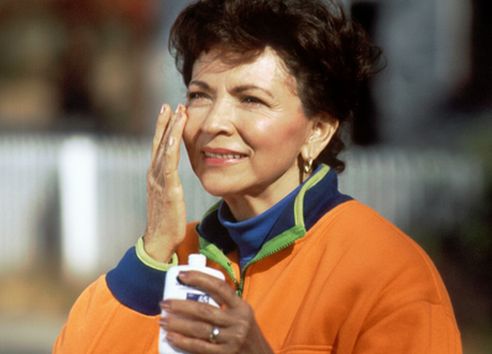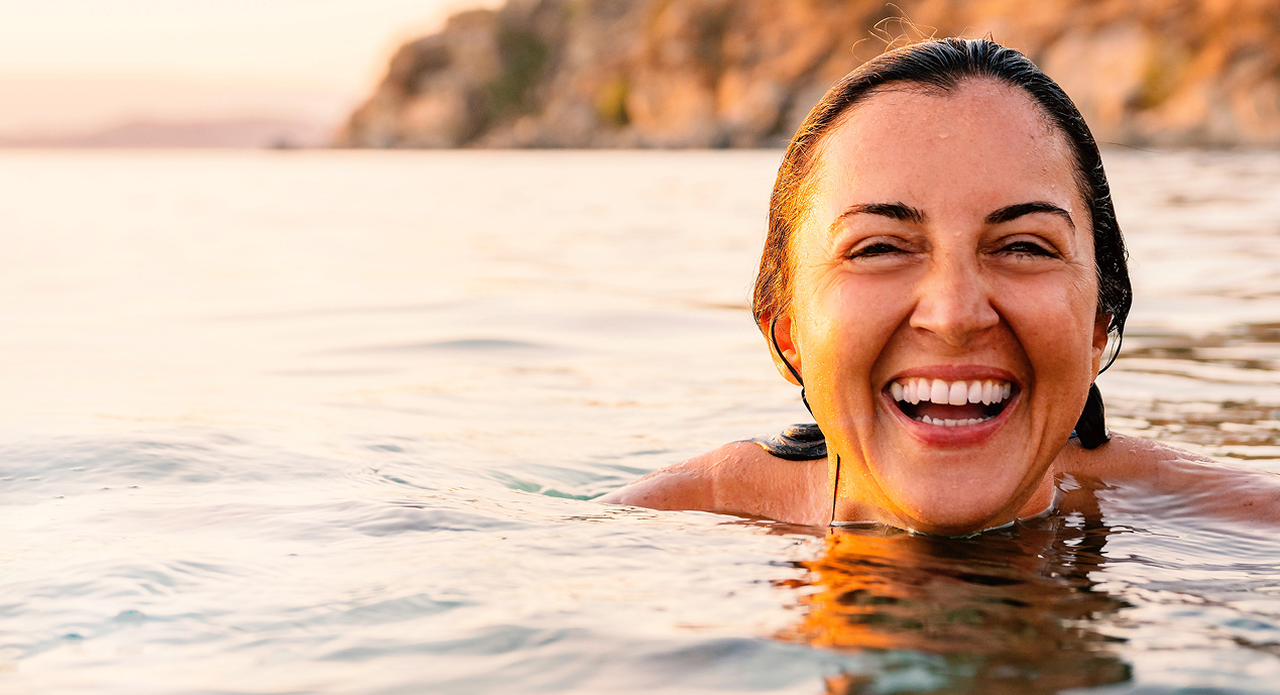What’s in my suncream?
Sun cream is used to protect us against sunburn and skin cancer. But did you know that your sun cream may also contain ingredients that could be harmful?

This summer the UK has reached record-breaking temperatures, which means we’re grabbing the high-factor sun cream more than usual! Sun cream is used to protect us against sunburn and skin cancer. But did you know that your sun cream may also contain ingredients that could be harmful?
Before we slather our skin with SPF 30, it’s important to ask ourselves what chemicals are found in sun cream. The active ingredients of sun creams are known as UV filters. In this blog, we discuss what these are and why we recommend using sun cream containing a mineral UV filter.
What causes sunburn and skin cancer?
Sunburn is skin damage caused by ultraviolet (UV) rays from the sun. Whilst generally short-lived and usually mild, it’s important to try to avoid it, as it can increase your chances of developing serious health problems, such as skin cancer, in later life.
The sun emits two types of UV radiation, both of which can cause skin damage. UVB rays can penetrate the outer layer of the skin and damage cells, causing sunburn. UVA rays penetrate the skin more deeply, causing damage to the skin’s supporting tissues, which results in skin ageing. Unprotected exposure to UVA and UVB damages the DNA in skin cells, producing mutations that can lead to skin cancer.
Sun cream is used to prevent sunburn and skin cancer by reducing the amount of UV radiation penetrating the skin.
Some UV radiation is necessary for vitamin D production, and many studies have found low levels of vitamin D are linked to an increased breast cancer risk. But too much sun can damage your skin and eyes (read more on vitamin D and breast cancer).
What are UV filters?
UV filters help reduce the amount of UV rays reaching the skin. There are two types of UV filters: mineral (also known as physical or inorganic) and chemical (or organic).
- Mineral UV filters mainly remain on the skin’s surface and form a physical barrier to deflect UV rays before they penetrate your skin.
- Chemical UV filters absorb UV light and convert it into heat energy. It is these we are concerned about.
There are around 50 different types of chemical UV filters. As well as being used in sun creams, they may be added to other personal care products, such as moisturisers to increase product stability or incorporated into textiles (such as clothes and furnishings) to prevent deterioration from light.
Many are persistent in the environment and harmful to aquatic life, particularly coral reefs. As a result, several (e.g. benzophenone-3) are banned in sun creams in some Pacific Island nations and states, including Palau and Hawaii.
Commonly used chemical UV filters include:
- benzophenones (e.g. benzophenone-3, also known as oxybenzone)
- avobenzone
- homosalate
- octylmethoxycinnamate (also known as octinoxate)
- 4-methylbenzilidenecamphor
- padimate O
- octisalate
- octocrylene
Do sun creams increase breast cancer risk?
Many commonly used chemical UV filters are endocrine disrupting chemicals (EDCs) that can mimic natural oestrogen found in our bodies. Lifetime exposure to oestrogen is an established risk factor for breast cancer.
Cell culture studies have shown chemical UV filters can increase the growth, spread and invasive properties of human breast cancer cells. Many are rapidly absorbed through the skin and have been detected in human breast tissue and body fluids, including breast milk, urine and blood.
Sun cream may also contain parabens, used as preservatives. Parabens, for example, propylparaben, have also been detected in breast tissue and human body fluids and can act as oestrogen mimics. Some sun creams are scented; we recommend avoiding these also, as they may contain phthalates (to carry scent). Certain phthalates may also act as oestrogen mimics.
It is very unlikely that the occasional use of sun creams that contain chemical UV filters (and/or parabens) will affect your breast cancer risk. However, long-term, regular exposure may increase your risk.
What sun cream should I use?
We recommend using sun cream that contains a mineral UV filter in non-nano form (nano-form materials are small enough to be absorbed by the skin and may harm aquatic life). Check for Zinc Oxide on the ingredient list.
This offers broad-spectrum protection against both UVB and UVA radiation. Spray and powder forms of sun creams should also be avoided due to the risk of inhalation.
Breast Cancer UK’s sun safety tips:
- Spend time in the shade on sunny days; avoid the sun between 12 pm and 3 pm.
- Wear suitable clothing such as long-sleeved tops and long trousers or skirts and a suitable hat
- Use a sun cream with a high SPF (sun protection factor). For extended exposure, use a broad-spectrum, water-resistant sun cream with an SPF of at least 30.
- Protect children and the elderly: they are especially prone to sunburn
- Protect your eyes by wearing suitable sunglasses, which offer 100% UV protection, as the sun can cause eye damage
- Distribute sun cream evenly over your body (including ears, nose and feet); re-apply regularly, especially after swimming. See the NHS guide on how to apply sun cream.
- Check your sun cream ingredients. Prior to purchase, you can consult our A to Z Chemicals of Concern in cosmetics and personal care products. Additionally, the Danish Consumer Council Taenk has tested several sun creams for the presence of EDCs. The results can be found here.
- If you urgently need sun cream, it’s better to use a sun cream with unwanted chemicals than to get sunburned.
Tip from our comms officer, Grace:
“Some sun creams may say ‘UV filter free of XYZ filter’ but this doesn’t mean they are free of all UV filters. We encourage you to do your own searching of ingredients – by checking sun cream ingredients lists against our list of A to Z Chemicals of concern.
Whatever you do this summer, whether you’re going abroad or staying home in the UK, remember to get protected from the sun and seek shade during the hottest times. Have a lovely summer!”
For more information on how to reduce your exposure to harmful chemicals, please read our Chemicals and our Environment section.
-
- The Skin Cancer Foundation (2021). UV Radiation and Your Skin. https://www.skincancer.org/risk-factors/uv-radiation/ (accessed 4 August 2022)
- NHS . inform. Sunburn. https://www.nhsinform.scot/illnesses-and-conditions/injuries/skin-injuries/sunburn (assessed 2 August 2022).
- Scottish Cancer Prevention Network. SCPN Newsletter Volume 6, Issue 3. Sun creams. https://www.cancerpreventionscotland.org.uk/newsletter/sun creams/ (assessed 2 August 2022)
- Matouskova, K. &Vandenberg, L. (2022). Towards a paradigm shift in environmental health decision-making: a case study of oxybenzone. Environmental Health 21:6. https://ehjournal.biomedcentral.com/articles/10.1186/s12940-021-00806-y
- Barr, L. et al. (2018). Measurement of concentrations of four chemical ultraviolet filters in human breast tissue at serial locations across the breast. Journal of Applied Toxicology 38: 1112–1120. https://doi.org/10.1002/jat.3621
- Majhi, P. D. et al. (2020). Effects of Benzophenone-3 and Propylparaben on Estrogen Receptor–Dependent R-Loops and DNA Damage in Breast Epithelial Cells and Mice. Environmental Health Perspectives 128 (1). https://doi.org/10.1289/EHP5221
- Miller, I. B. et al. (2021). Toxic effects of UV filters from sun creams on coral reefs revisited: regulatory aspects for “reef safe” products. Toxic effects of UV filters from sun creams on coral reefs revisited: regulatory aspects for “reef safe” products. Environmental Science Europe 33:74. https://enveurope.springeropen.com/articles/10.1186/s12302-021-00515-w
- Wang, J. et al. (2016). Recent Advances on Endocrine Disrupting Effects of UV Filters. International Journal of Environmental Research & Public Health. 13(8): 782. https://www.ncbi.nlm.nih.gov/pmc/articles/PMC4997468/
- Darbre, P. D. (2021). Endocrine disrupting chemicals and breast cancer cells. Advances in Pharmacology 92:485-520. https://pubmed.ncbi.nlm.nih.gov/34452695/
- Alamer, and Darbre, P. D. (2018). Effects of exposure to six chemical ultraviolet filters commonly used in personal care products on motility of MCF-7 and MDA-MB-231 human breast cancer cells in vitro. Journal of Applied Toxicology 38(2):148-159. https://pubmed.ncbi.nlm.nih.gov/28990245/
- Schneider, S. L. and Lim, H. W. (2018). A review of inorganic UV filters zinc oxide and titanium dioxide. Photodermatology, Photoimmunology & Photomedicine 35: 442–446. https://onlinelibrary.wiley.com/doi/epdf/10.1111/phpp.12439
